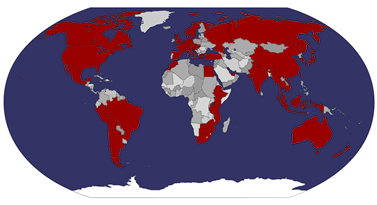
For 100 birr a night, I have a single room with large comfy bed, en-suite, and according to LP the best budget-hotel towels (soft and big!) in Ethiopia, woohoo! LP also says that the pillows are too soft but I find them perfectly acceptable. Tigist is the very sweet receptionist who writes out my details, including my name, in Amharic.

In return I play Teadras’s song, Abeba Ayush to her on my phone. The security chap, who usually wears a big flat hat, is very friendly too.
I meet the English girls, Farah, Rebecca and Laura, who were on my flight out of Addis, they’re here for a few months doing medical things. I head out,

and find myself in a public demonstration – apparently the combi drivers are not happy about the support they receive from the government.

Such bad timing on my part
First stop on the Gonder tour is the Royal Enclosure.




This is the gem in Gonder’s crown – a 70,000 sq metre site in the middle of town full of castles built by successive emperors in the 17th and 18th centuries. Inside the outer walls one finds Fasilides castle, Iyasu's Palace, Dawit's Hall, a banqueting hall, stables, Mentewab's Castle, a chancellery, library and three churches.




Gonder was the imperial capital of the Begember province. Until the 16th century, the Solomonic Emperors of Ethiopia usually had no fixed capital, instead living in tents in temporary royal camps as they moved around their realms while their family, bodyguard and retinue devoured surplus crops and cut down nearby trees for firewood. Gondar was founded by Emperor Fasilides around the year 1635, and grew as an agricultural and market town. There was a superstition at the time that the capital's name should begin with the letter 'Ga' (Gonder was originally spelt Gandar).



Tradition also states that a buffalo led the Emperor Fasilides to a pool beside the Angereb, where an "old and venerable hermit" told the Emperor he would locate his capital there. Fasilides had the pool filled in and built his castle on that same site. The emperor also built a total of seven churches; the first two, Fit Mikael and Fit Abbo, were built to end local epidemics. The five emperors who followed him also built their palaces in the town. Apparently Gonder has a total of 44 churches!





During the seventeenth century, the city's population is estimated to have exceeded 60,000 and was the second largest city in the world. In 1678, the visiting Armenian bishop Hovannes remarked that the city was "twice as big as Istanbul". Many of the buildings from this period survive, although the eighteenth century was a time of turmoil and the city declined.




The town served as Ethiopia's capital until 1855; the city was plundered and burnt in 1864, then devastated again in December, 1866. Abdallahi ibn Muhammad sacked Gondar when he invaded Ethiopia in 1887. After the conquest of Ethiopia by the Kingdom of Italy in 1936, Gondar was further developed under Italian occupation. Downtown Gondar shows the influence of the Italian occupation of the late 1930s. The main piazza features Italian-style shops, a cinema, and other public buildings. During the Second World War, Italian forces made their last stand in Gondar in November 1941, after Addis Ababa fell to British forces six months before. The area of Gondar was one of the main centres of activity of Italian guerrilla against the British forces until summer 1943.





During the Ethiopian Civil War, the forces of the Ethiopian Democratic Union gained control of large parts of Begemder, and during parts of 1977 operated within a few miles of Gondar, and appeared to be at the point of capturing the city. As part of Operation Tewodros near the end of the Civil War, Gondar was captured by the Ethiopian People's Revolutionary Democratic Front in March 1991.
For lunch I stop in a local restaurant for shiro and injera not far from the centre of town, the “telecom building junction”.

Next a church, Debre Behan Selassie, which is on a hill outside of town.

It’s not open when I arrive, it would appear everything closes for an hour over lunch.


After touring round in the peaceful gardens, I wait till they open up, when I can buy a ticket across the road. A priest then appears and opens up the doors.

Inside it’s dark, but he points out things to me, such as the disciples, and interestingly Mohammed. The real feature though is 104 angels on the roof.

On the way out, I notice that there is a strange tree outside – standing on its own in the middle of the road, it’s protected by a wooden structure, and inside a woman sits on a chair reading aloud, by herself.

Down the other side of town, I eventually reach Fasiladas’ Bath. The Norwegian-sponsored project to renovate is still far from complete, so they’re not charging for entry (anyway the ticket from the Royal Enclosure is valid for this too).

Fasiladas' Bath is home to an annual ceremony which I missed by a mere week, Timket, where it is blessed and then opened for bathing. Crowds gather to celebrate the Epiphany (when Jesus was baptised I think) for the Ethiopian Orthodox Church.


Outside, I pass the “stadium”, an open area with a road running through the middle, and cows grazing the “seats”!

At the LP-recommended Abyssinia Café I have some mango juice which is so thick somehow it survives about four dilutions, then a macchiato which comes loaded with sugar already. The thick juice (think yoghurt consistency) appears to be the way they like it in Ethiopia, and it’s always served with a spoon.

Chatting with the owner, I try to explain that his café is recommended in my guidebook without success. I think he gets the impression that I’m going to write in my journal that I like the place. Each time I try to explain, he gets a different impression, also wrong, and says “now I am understand”!
Back up the hill partially via a combi bus, I wonder how much it will cost and have mentally pencilled in “no more than 10 birr” when I get charged 50 cents on alighting! Oops! Incidentally, I should mention the incredible bird life here. The English girls have coined the phrase “PEagle”, referring to eagles here being more common than pigeons, and it’s true – there are large eagles and birds of prey of all kinds absolutely everywhere, as common as sparrows back home. It seems strange that a breeding pair of ospreys back home would be local or even national news, yet here the sky is rarely without at least a few large graceful eagles circling, or even down at street level, their wings making a loud whooshing sound as they sweep past. According to one reference, lammergeyer, augur buzzards, Verreaux’s eagles, kestrels and falcons are all common around here.
High on a hill above town, there is a large Amharic character, Hollywood style. I find out it means “Ethiopian Millennium”. It sits just in front of the Ghoa Hotel, the best in town, which I intend to head up to, but via chatting with the English girls and a shower, somehow I never make it up, instead trying a Dashan beer with the Dutch couple. These two are driving round in a large jeep with a sleeping area above. They sold their house and have been travelling for a year and a half on the road. They’ve just come from Sudan (the border is close to here). As we drink, a Belgian couple turns up – they’ve done the same for the last two years! I am in awe!
The English girls and myself head out to Tuscany Restaurant for pizza. At night Gonder is a different city entirely, it seems to come to life, with Ethiopian national colour lights all over the place, the pavements buzzing, and people all heading to cafes, bars and restaurants. It’s a good atmosphere, and surprisingly different from the day.




No comments:
Post a Comment